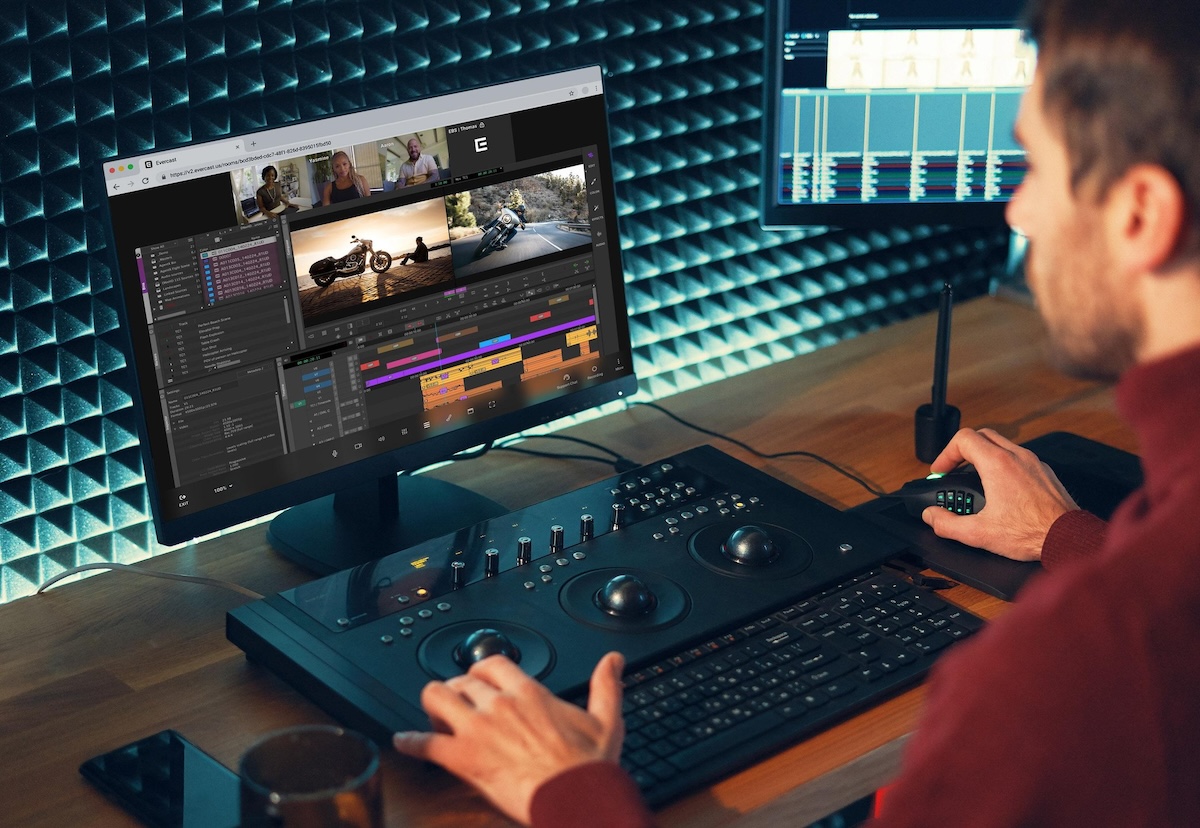Corporate teams can share their projects through remote meetings streamed over Zoom, so is there a way for audio and music production teams to do the same? Is it possible to stream a live recording or editing session over Zoom the same way you stream a meeting or presentation?
We’ve examined the features and capabilities of Zoom and Adobe Audition to see if Zoom can support live DAW streaming.
The challenges of streaming Adobe Audition over Zoom
Ok, let’s start with the bad news first. Zoom simply isn’t built to support streaming a platform like Adobe Audition natively. Zoom was designed for video meetings with only simple screen sharing of documents and web pages. There are no features that allow you to “cast” another program like Audition into the program.
Zoom does this by design. Zoom requires a significant amount of processing power to function.
If there is insufficient processing bandwidth available, its priority becomes maintaining the connection of the meeting. This means video and audio quality will take a hit while Zoom focuses on preventing the call from dropping entirely.
Adobe Audition (and other DAWs like it) also requires a significant amount of processing power. Running Adobe Audition simultaneously with Zoom can cause substantial problems for Zoom, which is why there are simply no native features to support it.
So, why try to swim uphill with a conferencing platform that isn’t designed for creatives? Well, almost everyone has Zoom, and almost everyone knows how to use it.
This means if you, the producer, can figure out how to stream your Adobe Audition workspace over Zoom, you’ll avoid that 45-minute phone call with your co-collaborators as you try to walk them through a new software install and initiation.
So the question that stands is this: will any workarounds be powerful enough to show your work in full detail but simple enough to make sense for your least tech-savvy team member?
We’ve compiled some common workarounds that creative teams can leverage to stream programs like Adobe Audition over Zoom and examined how functional they are for the demands of creative teams, both large and small.
Three ways to stream Adobe Audition over Zoom
In our research, we’ve found a few solutions that will allow you to stream your Adobe Audition.
Try an alternative
There is no perfect solution that results in low latency video streaming because Zoom was just not built to serve the needs of editing teams.
That’s the motivation for the creation of Evercast. This platform is designed to make streaming professional-grade DAWs like Adobe Audition nearly seamless.

Evercast allows you to stream your entire workspace in full HD with ultra-low latency (less than 150ms on average) while simultaneously video chatting with your entire team. This means no lag or pixelation, just a high-quality audio and video feed that feels as close to “being there” as possible:
- Your team can video and audio chat at the same time they are watching, allowing for instant feedback.
- Ability to draw on screen for more detail.
- No special hardware needed, no “hacks” necessary.
- 24/7 white-glove support.
- Dedicated apps for macOS, Windows, iPhone, iPad, Apple TV, and Apple Vision Pro.
- Supports up to 10-bit 4:4:4 color.
- 5.1 and 7.1 surround sound support.
- 4K/60fps streaming of any editing workflow via Premiere Pro, any other NLE or creative software, media files, and more.
- Encrypted video streams and two-factor authentication required to join secure rooms.
- Approved by ALL major studios and OTT content providers.
Nobody has to download any additional software to participate in a meeting. Just follow the link and join from any device, anywhere in the world.
If you’re looking for a better way to bring your team closer together and collaborate more efficiently from a distance, check out Evercast. We make it possible for producers to recreate the feeling of gathering in the recording studio, whether they’re across the city or the world.
Create together remotely, in real time

If you're not ready for a solution like Evercast, here are some other workarounds to stream Adobe Audition over Zoom. Most of them will require at least one additional piece of software, and some require other hardware as well.
Workaround #1: Two CPUs and OBS
This solution requires:
- Two separate screens
- Two separate CPUs (for best performance)
- A broadcasting program like OBS (Open Broadcasting Software)
- An NDI (Network Device Interface)
This workaround will require you to download an NDI to the system running Adobe Audition and download OBS to the system you’ll run Zoom on. Once these programs are in place, open Adobe Audition and your NDI and use the NDI to broadcast a feed of your screen.
Now, open OBS, locate the NDI stream on the other system and set it as your video source. You should now see a live broadcast of your Adobe Audition workspace.
The last step is to open Zoom and set your camera as the feed from OBS. This will allow you to broadcast your workspace to meeting participants over Zoom as if it were your webcam.
This workaround allows you to broadcast your workspace, but Zoom video and audio quality will likely still suffer.
Workaround #2: A capture card
If you have two separate systems and don’t want to deal with the hassle of setting up an NDI, you can purchase a capture card that can receive the signal from one system and broadcast it to a second.
This is an external device that can be somewhat costly, but if you plan on using it regularly, the expense may be worth it.
To use it, plug it into the system running Adobe Audition using an HDMI cable. Then run the signal back out to the system running Zoom using a second cable. You’ll still need to download OBS to receive the signal and broadcast it to Zoom. You can do this after the final step above.
You’ll also need an external microphone to pick up your voice. You can configure this level with the level of the software feed inside of OBS.
A big disadvantage to this is cost and mobility. Capture cards can be expensive, and this setup will require you to have enough physical space to wire everything together and still be able to actively edit.
Workaround #3: A second webcam
If you don’t feel like learning the ins and outs of installing, connecting, and streaming an NDI feed, don’t want to use OBS, and don’t want to shell out big bucks for an expensive capture card, you can use this lower-tech workaround.
Get an external webcam, point it at your screen running Adobe Audition, then stream the webcam feed to Zoom as your video input. This will solve some of the Zoom downgrade issues, as most webcams stream in 1080p. However, the video quality of a webcam pointed at a screen is hardly the HD experience you may be looking for.
Also, there’s a massive problem with this workaround: sound. While there are many benefits to seeing the workspace, what you need to be able to do is hear the project with as little distortion as possible. If you’re pointing a webcam at the screen, you’ll be relying on your microphone to pick up your speaker audio, causing lots of distortion.
In addition, the only way to stream your face simultaneously is by running both webcams through OBS first to combine them into a single video feed.
So the first question is, do these workarounds work? Yes, they technically do, but in real-world use, they lack consistency and quality.
If you want a truly seamless experience, you’ll need a purpose-built system for creative teams and their HD workspaces. Thankfully, there is a platform built specifically for your needs: Evercast.
















.avif)









.avif)


.avif)